ARCHIVED - RCMP External Review Committee - Report
 This page has been archived.
This page has been archived.
Archived Content
Information identified as archived on the Web is for reference, research or recordkeeping purposes. It has not been altered or updated after the date of archiving. Web pages that are archived on the Web are not subject to the Government of Canada Web Standards. As per the Communications Policy of the Government of Canada, you can request alternate formats on the "Contact Us" page.
2010-11
Departmental Performance Report
RCMP External Review Committee
The original version was signed by
The Honourable Vic Toews, P.C., Q.C., M.P.
Minister of Public Safety
Table of Contents
Section I: Organizational Overview
- Raison d’être and Responsibilities
- Strategic Outcome and Program Activity Architecture (PAA)
- Organizational Priorities
- Risk Analysis
- Summary of Performance
- Expenditure Profile
- Estimates by Vote
Section II: Analysis of Program Activities by Strategic Outcome
Section III: Supplementary Information
- Financial Highlights
- Financial Highlights Charts
- Financial Statements
- List of Supplementary Information Tables
Section IV: Other Items of Interest
Chair's Message
I am pleased to present this report to demonstrate measurements of the RCMP External Review Committee's (ERC) performance using the federal government's modern reporting framework. Despite the long history of the Departmental Performance Report, it continues to be a publicly relevant report given the updated mechanisms within the Report that now permit departments and agencies to determine valid indicators of performance and to set targets to be achieved. Through the development of its Program Activity Architecture, the ERC has identified a framework in which program activities are directly linked to its Strategic Outcome. The excellence of each of its program activities is assessed using measurable indicators. In its Report on Plans and Priorities published before the beginning of the 2010-11 fiscal year subject to this report, the ERC set attainable targets to achieve during the subsequent year. This present Departmental Performance Report tracks the ERC's progress toward these targets.
To best understand this Report the reader must be aware of the remarkably small size of the ERC relative to the vast majority of organizations within the greater federal public service that publish the same Report. The ERC is staffed by five (5) permanent public servants in addition to my position to which I am appointed for a term by Order-in-Council. Temporary funding has been provided to permit the retention of three (3) additional staff on a temporary basis. As the sole member of the ERC, I have the authority to reach findings and to make recommendations to the Commissioner of the RCMP, which is the essence of the ERC's statutory mandate.
At its core, the ERC's role is to conduct impartial and independent reviews of RCMP labour relations cases. Its aim is to positively influence the manner in which labour relations issues are addressed within the RCMP. This contributes to the confidence and trust that Canadians put in the administration of the Force, knowing that principles of fairness and statutory compliance are upheld in a transparent and credible manner.
In addition to reporting its findings and recommendations to the Commissioner of the RCMP, the ERC's reports are accessible to all those who have an interest in resolving member grievances and appeals through rational decisions based on sound judgment. Members, managers, their representatives and Canadians at large have made frequent reference to the ERC's online repository of precedents to search for past findings and recommendations as well as RCMP Commissioners' decisions and authoritative case law. This is an excellent low-cost utility that supports the RCMP's grievance and discipline processes and that ultimately benefits all Canadians.
The ERC has continued to prudently use the resources entrusted to it.
The original version was signed by
Catherine Ebbs, Chair
Catherine Ebbs
Chair
Section I: Departmental Overview
Raison d’être and Responsibilities
The RCMP External Review Committee (ERC) is an independent and impartial agency that aims to promote fair and equitable labour relations within the RCMP, in accordance with applicable principles of law. To this end the ERC conducts an independent review of appeals in disciplinary, and discharge and demotion matters, as well as certain categories of grievances that are referred to it pursuant to s. 33 of the RCMP Act and s. 36 of the RCMP Regulations.
The ERC reports directly to Parliament through the Minister of Public Safety. The ERC has a single member, the Chair, who is appointed by an Order-in-Council, and is supported by an Executive Director and a very small staff. The ERC's jurisdiction is restricted to employment and labour matters that relate to regular members and civilian members of the RCMP only. Public servants employed by the RCMP have separate labour relations processes. The role of the ERC in the Force's labour/management resolution process is a crucial one. Over the years, the RCMP has made changes in a variety of areas based on recommendations made by the ERC.
As one of two oversight/review bodies for the RCMP, the ERC plays an important role in maintaining public confidence in the RCMP and ensures that it respects the law and human rights.
The ERC is within the portfolio of Public Safety Canada whose Minister is the appropriate Minister responsible for the purposes of the Financial Administration Act. The ERC's mandate is simply put: the independent and impartial review of grievances as well as appeals that involve the discipline, discharge or demotion of RCMP members. Upon completing its review of a case, the ERC presents findings and recommendations to the Commissioner of the RCMP for a final decision. The Commissioner is not bound by the recommendations of the ERC, but the Commissioner must provide reasons when there is disagreement with the recommendations of the ERC. In carrying out its mandate, the ERC ensures that its recommendations are solidly grounded in law and that members of the RCMP are treated in a fair and equitable manner, in keeping with the public interest.
Strategic Outcome and Program Activity Architecture (PAA)
Strategic Outcome
The RCMP External Review Committee aims to positively influence the manner in which labour relations issues are addressed within the RCMP.
Program Activity Architecture
| Strategic Outcome The RCMP External Review Committee aims to positively influence the manner in which labour relations issues are addressed within the RCMP. |
|
|---|---|
| Program Activity 1 Independent and impartial case review |
Program Activity 2 Outreach and information dissemination |
| Internal Services | |
Internal Services
In an agency as small as the ERC, individuals conduct duties that span program activities and similarly, supplies and equipment is shared among both program activities on a routine basis. Due to the impracticability of tracking internal services separately on an ongoing basis, the ERC has been granted an exemption until the end of the 2010-11 fiscal year from reporting on financial commitments to Internal Services as a separate program activity.
Organizational Priorities
| Priority | Type | Strategic Outcome and/or Program Activity |
|---|---|---|
| Continue to deliver on statutory mandate | Ongoing | Strategic Outcome and Program Activity 1 |
| Status: Met all | ||
|
||
| Priority | Type | Strategic Outcome and/or Program Activity |
|---|---|---|
| Raising awareness through outreach | Ongoing | Strategic Outcome and Program Activity 2 |
| Status: Met all | ||
|
||
| Priority | Type | Strategic Outcome and/or Program Activity |
|---|---|---|
| Continue to improve on the corporate management framework and infrastructure | Ongoing | Strategic Outcome and Program Activity 1 and 2 |
| Status: Met all | ||
|
||
| Priority | Type | Strategic Outcome and/or Program Activity |
|---|---|---|
| Continue to invest in our people | Ongoing | Strategic Outcome and Program Activity 1 and 2 |
| Status: Met all | ||
|
||
Risk Analysis
Since 2006, the ERC's base budget has been augmented by a series of temporary grants of funding from the Treasury Board's Management Reserve to allow it to meet the obligations of its mandate and to ensure the accountability of its operations. The terms of all of these temporary appropriations will expire at the end of fiscal year 2011-12.
Significantly, the most recent Treasury Board grant of temporary funding recognized the need to increase the ERC's services in order to achieve a permanent sustainable resourcing level. The funds were intended to bridge the ERC's operations until a permanent solution was achieved. The three-year strategy provided for additional staff in 2010-2011 as well as a consolidation of its office space to accommodate them. A Human Resources (HR) staffing strategy was designed to take effect at the beginning of this year. In the previous year in preparation for the changes, a project to make adequate space available was commenced in partnership with Public Works and Government Services Canada (PWGSC).
The ERC completed the office consolidation in 2010-11, however its staffing strategy was curtailed early in the year when a government bill proposing to dissolve the ERC was tabled in Parliament. Prudent fiscal management dictated that the ERC would not proceed with increasing its obligations in the circumstances. In fact, the ERC's obligations diminished as some staff sought to secure permanent employment elsewhere. The ERC continued with its operational priority of reviewing appeals of discipline with serious consequences, and successfully completed the most such cases within one year in its history. While the total number of reports declined, the significance and quality of those particular findings and recommendations remained high. This led to a consolidation of two quarterly Communiqué into one single issue. While the bill did not proceed to enactment, the events resulted in lower than planned expenditures and thus contributed to an unusually high return of funds to the Consolidated Revenue Fund.
In addition to case reviews, the ERC workload also includes significant reporting and corporate requirements that apply to all public service organizations. Given its small size, the ERC does not employ staff solely tasked to exercising these reporting processes. The ERC often re-assigns operational staff to work on these corporate reports. This leads to a melding of expenditures on support services and operational mandate and it also contributes to delays in the case review process. To alleviate this pressure, the ERC makes use of contracted professional services to perform these internal corporate services whenever possible. To that end, among other specific contracts, the ERC has benefited from an arrangement through a Memorandum of Understanding with its host department, Public Safety Canada, to provide transactional support services in areas of information technology, HR and finance. Should the ERC be unsuccessful in achieving a permanent increase in its appropriation subsequent to 2011-12, these arrangements will be threatened. More staff time will be needed to maintain our corporate obligations which will likely lead to further delays in completing cases.
Summary of Performance
| Planned Spending | Total Authorities | Actual Spending |
|---|---|---|
| $1,811 | $2,371 | $1,784 |
| Planned | Actual | Difference |
|---|---|---|
| 8 | 7 | 1 |
| Performance Indicators | Targets | 2010-11 Performance |
|---|---|---|
| Issuance of findings and recommendations to the RCMP Commissioner and the parties | 100% | Maintained 100% performance level |
| Information to the public and the RCMP | 100% | Maintained 100% performance level |
| Program Activity | 2009-10 Actual Spending ($ thousands) |
2010-11 ($ thousands) | Alignment to Government of Canada Outcomes | |||
|---|---|---|---|---|---|---|
| Main Estimates |
Planned Spending |
Total Authorities |
Actual Spending |
|||
| Independent and impartial case review | $1,457 | $1,449 | $1,449 | $1,892 | $1,463 | Well-managed and efficient government operations |
| Outreach and information dissemination | $157 | $362 | $362 | $479 | $321 | A transparent, accountable and responsive federal government |
| Total | $1,614 | $1,811 | $1,811 | $2,371 | $1,784 | |
Internal Services
In an agency as small as the ERC, individuals conduct duties that span program activities and similarly, supplies and equipment is shared among both program activities on a routine basis. Due to the impracticability of tracking internal services separately on an ongoing basis, the ERC has been granted an exemption until the end of the 2010-11 fiscal year from reporting on financial commitments to Internal Services as a separate program activity.
Expenditure Profile
The receipt of a temporary increase in spending authorities contributed to the ERC's success in achieving its targets. Staffing determinate positions in an uncertain environment led to a lag in spending evident in the chart below.
| Fiscal Year | Planned Spending ($ thousands) |
Total Authorities ($ thousands) |
Actual Spending ($ thousands) |
|---|---|---|---|
| 2008-09 | $1,485 | $1,559 | $1,393 |
| 2009-10 | $1,074 | $1,969 | $1,614 |
| 2010-11 | $1,811 | $2,371 | $1,784 |
Estimates by Vote
As indicated above, actual spending resulted in lower than planned expenditures due to an uncertain environment.
For information on our organizational votes and/or statutory expenditures, please see the 2010-11 Public Accounts of Canada (Volume II) publication. An electronic version of the Public Accounts is available on the Public Works and Government Services Canada website (see Public Accounts of Canada 2010,
http://www.tpsgc-pwgsc.gc.ca/recgen/txt/72-eng.html).
Section II: Analysis of Program Activities by Strategic Outcome
Strategic Outcome
The RCMP External Review Committee aims to positively influence the manner in which labour relations issues are addressed within the RCMP.
In order to work towards achieving its Strategic Outcome, the ERC carries on two program activities: Program Activity 1 Independent and impartial case review; and Program Activity 2 Outreach and information dissemination.
In fiscal year 2009-10, the Program Activity Internal Services was appended to the ERC's Program Activity Architecture. As a result of its experience in attempting to meet the reporting requirements, the ERC determined that the uniquely small size of the organization made the reporting of this program activity particularly inaccurate. The related expenditures cannot be reliably apportioned between program activities without an inordinate expenditure of resources. This justification was provided to Treasury Board who in turn agreed with the ERC's assertion. As such, the ERC has been granted an exemption until the end of the 2010-11 fiscal year from reporting on financial commitments to Internal Services as a separate program activity.
Program Activity 1: Independent and impartial case review
Program Activity Description
The ERC can dispose of matters referred to the ERC by the Royal Canadian Mounted Police (RCMP) either on the basis of the material in the record or following a hearing. In conducting its review of matters referred to it, the ERC attempts to achieve timeliness and quality in its recommendations, and a balance amongst the many complex and different interests involved. It strives to ensure that the principles of administrative and labour law are respected and the remedial approach indicated by the Royal Canadian Mounted Police Act is followed. In each case, the ERC must consider the public interest and ensure that members of the RCMP are treated in a fair and equitable manner.
| Planned Spending | Total Authorities | Actual Spending |
|---|---|---|
| $1,449 | $1,892 | $1,463 |
| Planned | Actual | Difference |
|---|---|---|
| 6 | 5 | 1 |
| Expected Results |
Performance Indicators |
Targets | Performance Status |
|---|---|---|---|
| Parties and RCMP Commissioner are provided with an independent review of the dispute to facilitate transparent and accountable dispute resolution. | Percentage of cases where findings and recommendations are issued. | 100% | Met All |
| A body of findings and recommendations is created to assist RCMP Level 1 Adjudicators, concerned parties, RCMP Commissioner and staff representatives to interpret legislation, regulations and policy. | Number of times legislative, regulatory or policy interpretative guidance provided in findings and recommendations. | As required | Met all |
| Identification of areas for legislative, regulatory or policy change/clarification. | Number of recommendations for change/clarification provided in findings and recommendations. | As required | Somewhat met |
Performance Summary and Analysis of Program Activity
Case Review
The ERC concludes matters referred to it by the RCMP either on the basis of the material in the record or following a hearing. In conducting its reviews, the ERC attempts to achieve timeliness and quality in its analysis and recommendations, and an equitable balance between all of the interested parties. It relies on the principles of administrative and labour law and it respects the remedial approach indicated by the RCMP Act. In each case, the ERC considers the public interest along with the members' interest in fair and equitable treatment.
The statutory mandate of the ERC in the RCMP Act is case review and it is in this respect that Program Activity 1 supports Priority 1.
Referrals
Sixteen case files were referred to the ERC in 2010-11: 15 grievances and 1 disciplinary appeal. The ERC received no referrals of discharge and demotion appeals this year.
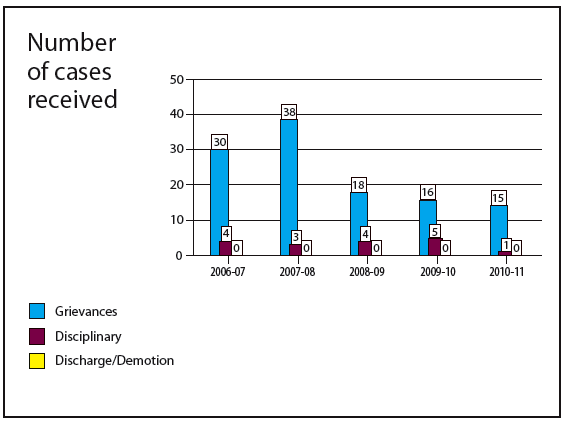
Cases Completed and Recommendations Issued
The ERC completed 23 cases in 2010-11: 15 findings and recommendations were issued regarding grievances and eight were issued regarding disciplinary appeals. No cases were withdrawn before the ERC could issue its findings and recommendations. The ERC did not issue any findings and recommendations in discharge or demotion cases this year.
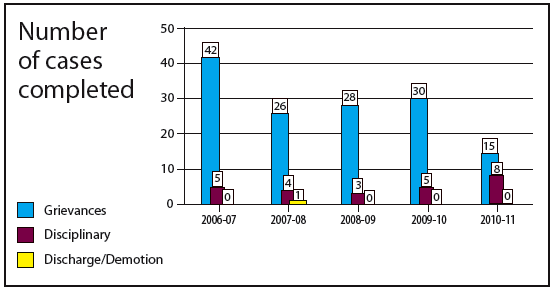
Grievance Reviews
The chart below shows the distribution of this year's grievance recommendations by subject matter.
In the last few years, travel, harassment, and relocation issues accounted for a significant portion of grievance reviews. In 2010-11, travel and harassment issues combined represented two-thirds of all the grievance recommendations issued.
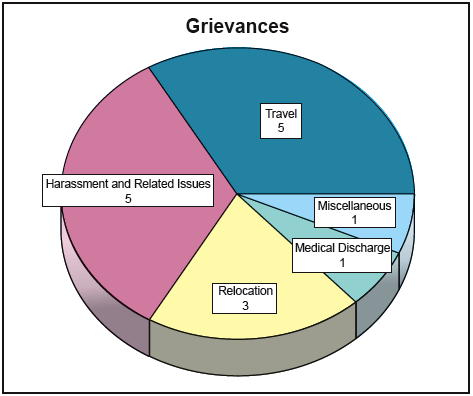
Disciplinary Appeals
This year, the ERC reviewed and made recommendations in eight disciplinary appeals. Six were initiated by a member. Three involved a sanction consisting of an order to resign within 14 days or be dismissed from the Force. The other three involved a forfeiture of pay and reprimand. The ERC recommended that four appeals be dismissed, that one be allowed and that one be allowed in part.
Two disciplinary appeals were initiated by the Appropriate Officer. The ERC recommended that both of these appeals be dismissed.
Processing
For grievances, the ERC's objective is to issue its findings and recommendations within three months of the case being referred to it. For discipline and discharge and demotion cases, it strives for a standard of six months. These service standards are not currently being met. The ERC continues to pursue avenues for a permanent resource allocation that will allow it to reach and sustain an acceptable review rate.
At the start of 2010-11, 46 grievances and appeals were pending before the ERC. At the fiscal year end of 2010-11, there were 39 cases before the ERC for review. They were distributed as follows:
- 34 pending grievances;
- 5 pending disciplinary appeals; and
- 0 pending discharge and demotion appeals.
This reduction in the number of pending cases signals a move toward a shorter delay for cases before the ERC. If this trend continues, the ERC will reach the point where its turn-around rate will be reasonable. However if the relatively small number of cases that reach the ERC ever surges, the delays will again increase significantly. This occurred one year when the ERC received 30 cases more than it received historically and it created lengthy delays in the processing of subsequent cases.
Other Activities
In addition to its case review function, the ERC must meet every statutory obligation required of all departments in the Public Service. The ERC is fully committed to delivering on its mandate, while ensuring compliance with legislation and policy.
The ERC's workload includes disproportionately significant reporting and corporate requirements. The ERC has few staff members who are involved in the collection, analysis and reporting of its corporate data to the central agencies that oversee the various aspects of management. As a result, these staff members are called upon to become the ERC's subject matter experts for a number of different areas including procurement, finance, human resources and knowledge management. These staff members assume many roles to address corporate management demands in order to meet the same reporting requirements of large departments and agencies. The ERC also uses a variety of external consultants to ensure that it thoroughly meets all of its obligations. Given the ERC's small size and budget, these reporting pressures take combined human and financial resources away from the case review process.
Lessons Learned
The events of this past year served to remind the staff and management of the ERC that uncertainty can be alleviated through immediate revisions to operations and related expenditures. The ERC's plans allowed it to scale back at a moment's notice as events transpired and to re-organize its priorities. It was of prime importance that the ERC keep in close communication with parties interested in its mandate and funding. The ERC gained excellent advantage from its reputation for faithfully exercising its mandate and managing its operations responsibly. Its good rapport with partners served to secure good support for contingency planning.
Program Activity 2: Outreach and information dissemination
Program Activity Description
The ERC ensures that its finding and recommendations in each case are clearly explained for the parities and the RCMP Commissioner. Summaries of the findings and recommendations in each case, as well as articles of interest on the role of the ERC, relevant legal principles and information on related issues, are distributed widely. Communication and outreach tools include: a quarterly publication (Communiqué) including the most recent case summaries, updates, and legal principles; a website with timely inclusion of publications and cases summaries; the annual report and other government accountability documents; and presentations, meeting, training and other outreach activities.
| Planned Spending | Total Authorities | Actual Spending |
|---|---|---|
| 362 | 479 | 321 |
| Planned | Actual | Difference |
|---|---|---|
| 2 | 2 | 0 |
| Expected Results |
Performance Indicators |
Targets | Performance Status |
|---|---|---|---|
| Make available information to the public on labour relations issues within the RCMP to support accountability and transparency. | Subscription levels for quarterly Communiqué; subscription levels for annual report; website traffic; volume of requests for information. | Ongoing | Exceeded |
| Increase awareness of labour relations issues and resolutions within RCMP Policy. | Website access statistics; subscription and distribution data; number of requests for information; number of outreach events. | Ongoing | Exceeded |
Performance Summary and Analysis of Program Activity
The ERC strives to make timely information accessible and achieved both its paper and electronic distribution targets as well as its digital posting targets. Subscriptions levels have remained constant and website traffic has increased more than anticipated. As a result, the utility and the credibility of its website holdings is progressively becoming better recognized and indicate greater accessibility and increased awareness.
Summaries of the ERC's findings and recommendations in each case, as well as articles of interest, relevant legal principles and information on related issues, are distributed widely. Communication and outreach tools include: a quarterly publication (Communiqué); a website with inclusion of publications and case summaries; the annual report; and presentations, meetings, offered training and other outreach activities.
This part of the ERC's work is dedicated to Program Activity 2, and it directly supports Priority 2.
Requests for Information
The ERC also responds to formal and informal requests for information. In 2010-11, the ERC received a total of 116 requests. On average, the ERC provided an answer to each request within three days. Over two-thirds of the requests came from the RCMP itself. Members of the public were the second largest group of requesters.
The graphs below illustrate the general categories of requests received and their sources. Several requests were straightforward and requesters were provided with a timely response or were re-directed to the appropriate office. However, other requests were complicated and required more time and effort for a complete and accurate response. By far, the median response time was one day, indicating that a smaller number of complex inquiries were significantly time-consuming.
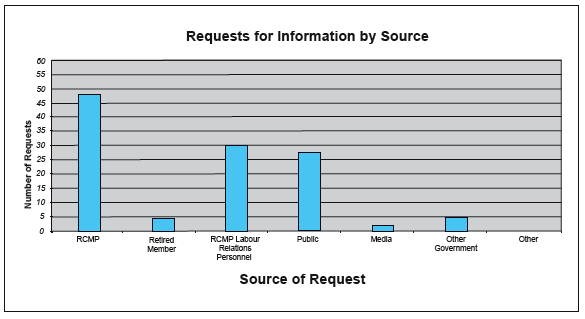
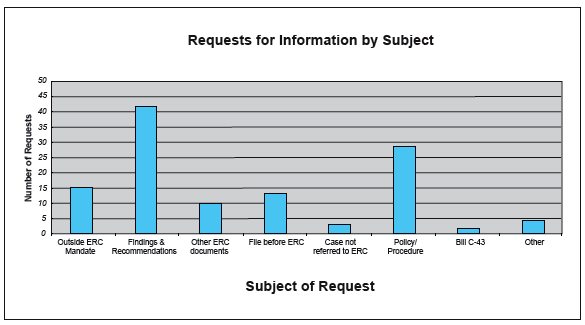
Lessons Learned
The events of this past year served to remind the staff and management of the ERC that uncertainty can be alleviated through immediate revisions to operations and related expenditures. The ERC's plans allowed it to scale back at a moment's notice as events transpired and to re-organize its priorities. It was of prime importance that the ERC keep in close communication with parties interested in its mandate and funding. The ERC gained excellent advantage from its reputation for faithfully exercising its mandate and managing its operations responsibly. Its good rapport with partners served to secure good support for contingency planning.
Section III: Supplementary Information
Financial Highlights
| % Change | 2010-11 | 2009-10 | |
|---|---|---|---|
| Total Assets | 343.0 | $415,355 | $93,729 |
| Total Liabilities | 63.5 | $416,758 | $254,967 |
| Equity of Canada | (99.1) | ($1,403) | ($160,967) |
| Total | 343.0 | $415,355 | $93,729 |
| % Change | 2010-11 | 2009-10 | |
|---|---|---|---|
| Total Expenses | 4 | $1,824,264 | $1,757,240 |
| Total Revenues | - | $5 | $0 |
| Net Cost of Operations | 4 | $1,824,259 | $1,757,240 |
Financial Highlights Chart
| 2010-11 | 2009-10 | |
|---|---|---|
| Salaries & employee benefits | $1,264,242 | $1,196,506 |
| Professional & special services | $275,822 | $339,728 |
| Accommodation | $138,517 | $110,050 |
| Equipment | $20,919 | $3,281 |
| Information | $21,523 | $24,546 |
| Communication | $10,981 | $20,757 |
| Travel & relocation | $13,329 | $6,759 |
| Utilities, material & supplies | $11,451 | $13,319 |
| Equipment rentals | $31,106 | $28,510 |
| Settlement out of Court | $0 | $10,000 |
| Interest | $0 | $8 |
| Amortization | $8,607 | $3,806 |
| Repairs | $27,768 | $0 |
| Total Expenses | $1,824,264 | $1,757,240 |
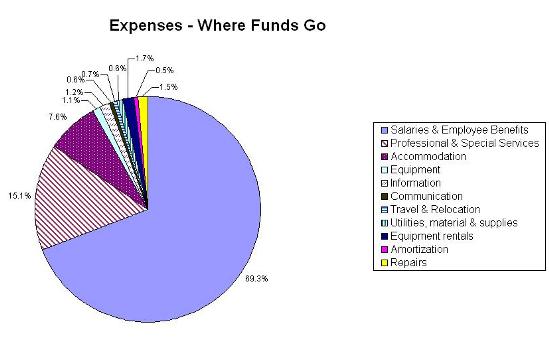
Financial Statements
The ERC's 2010-11 financial statements can be found on its website at www.erc-cee.gc.ca.
List of Supplementary Information Tables
All electronic supplementary information tables found in the 2010-11 Departmental Performance Report can be found on the Treasury Board of Canada Secretariat's website at http://www.tbs-sct.gc.ca/dpr-rmr/2010-2011/index-eng.asp.
- User Fees Reporting
- Internal Audits and Evaluations
Section IV: Other Items of Interest
Organizational Information
The ERC reports directly to Parliament through the Minister of Public Safety. The ERC has a single member, the Chair, who is appointed by Order-in-Council.
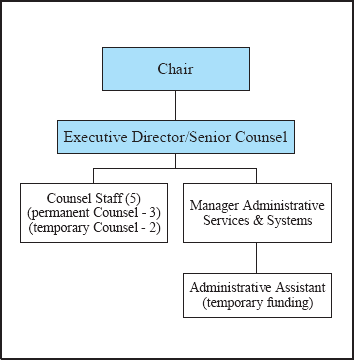
Organizational Contact Information
David Paradiso
Executive Director and Senior Counsel
RCMP External Review Committee
P.O. Box 1159, Station B
Ottawa, Ontario
K1P 5R2
Telephone: (613) 998-2874
Fax: (613) 990-8969
Email: org@erc-cee.gc.ca
Internet: www.erc-cee.gc.ca